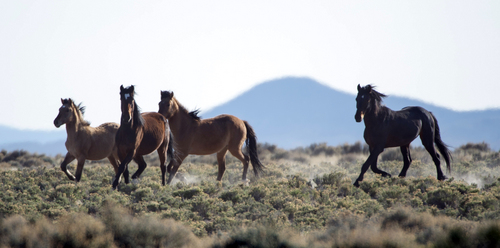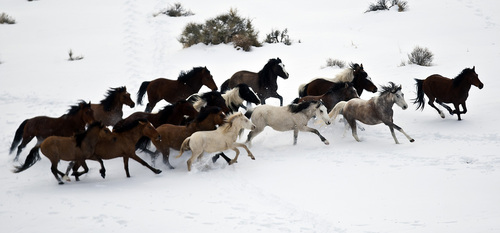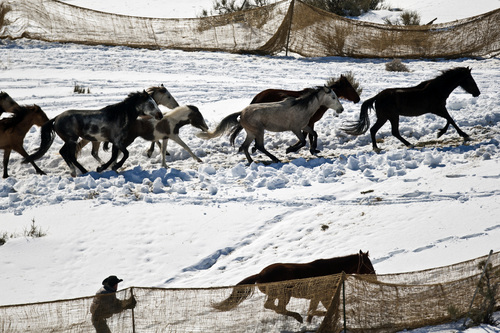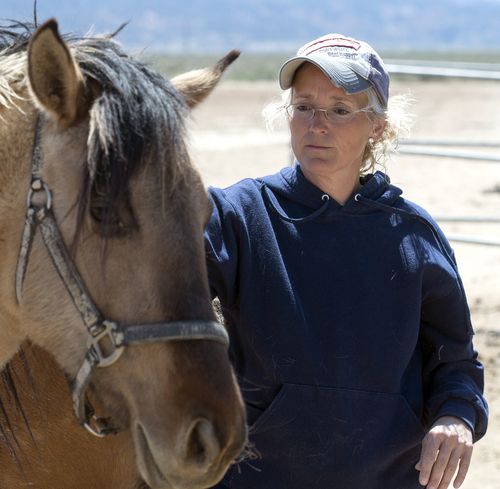This is an archived article that was published on sltrib.com in 2014, and information in the article may be outdated. It is provided only for personal research purposes and may not be reprinted.
As the Shingle Creek Fire spread two years ago, Kane and Iron county officials fumed, blocked by federal land managers from attacking it with the four bulldozers the counties wanted to deploy.
That frustration and others led to HB164, which called for empowering Utah's local government officials to act on public lands when they believe federal mismanagement is endangering public health and safety.
But the 2013 law's first target is not the beetle-killed timber that lawmakers fear the U.S. Forest Service is not thinning fast enough, creating wildfire risks. Instead, Iron and Beaver counties are using it to sail into an uncharted legal area as they threaten to pull federally protected wild horses from the West Desert range.
And Utah taxpayers could end up on the hook for their defense, should any future actions end up violating the 1971 federal Wild Horses and Burros Act.
The law is one of several from the Utah Legislature that aims to limit federal control over public lands, with the most far-reaching demanding title to 30 million federal acres be transferred to Utah by the end of this year.
—
Defining the threat • In their recent letters to the Bureau of Land Management (BLM), Iron and Beaver county commissioners say a proliferation of federally protected wild horses is threatening public welfare.
The danger: The horses' impact on the drought-stricken range may force ranchers to reduce their cattle grazing.
The officials are demanding the BLM reduce the number of horses or they will do it themselves, in apparent defiance of the Wild Horses and Burros Act, which imposes criminal penalties on those who harass these free-roaming animals.
But the new state law offers counties this protection: If the feds take legal action against them, the Utah Attorney General's office must review the case and may, at its discretion, defend the county in court.
To enjoy that safeguard, Iron and Beaver must demonstrate their claim that the horse overpopulation constitutes an "imminent threat" to public health, safety and welfare.
Iron County has consulted with the office, which has yet to develop an interpretation of what constitutes such a threat, says Harry Souvall, who heads the AG's public lands division.
HB164 was designed to give counties greater leverage over how the BLM and U.S. Forest Service administer land within their borders. These agencies lack of promptness in authorizing timber sales and other actions has long angered local officials.
This past session, HB67 expanded the scope of the law to cover lands administered by the National Park Service and the U.S. Fish and Wildlife Service. It also requires counties to consult with the Utah Attorney General as they prepare to take action on federal land, and says state lawyers will serve as a go-between with the feuding state and federal agencies.
—
The wild horse challenge • Even without HB164, Iron County Commissioner Dave Miller contends, the BLM's failure to control horse numbers amounts to "a de facto authorization" for the counties to act.
He argues the federal wild horses law obligates the Department of Interior to promptly remove horses if their numbers exceed recommended population thresholds.
"They have done nothing for 15 years and that's why the horse overpopulation is at an extreme level," Miller said.
He says ranchers have a "property right" to graze the public lands that is as valid as other citizens' right to breathe. Forcing ranchers to reduce grazing levels to accommodate excess horses is tantamount to an illegal "taking," he said.
Horse welfare advocates contend it is the ranchers' cattle, who graze public lands at highly subsidized rates, who are damaging the range. While estimates of the number of horses vary, there is no disputing cows far outnumber them in the West Desert.
"That land belongs to the citizens of the United States. They are robbing us of our legacy by taking control of it," said Paula Todd King of the Cloud Foundation.
Meanwhile, the BLM spends $72 million a year on its wild horse program, gathering hundreds of horses, administering contraceptives to mares and adopting out as many as the public can take. More than 50,000 horses are corralled for life at enormous public expense.
The counties have agreed to postpone any roundup until July, when foaling season is over, even though they say horses are causing the most damage now as leafy forage emerges with the spring.
And the BLM this week began an environmental review of a new proposal to remove several hundred horses from Iron and Beaver counties' horse management areas. But that plan will compete for funding with other proposals for BLM roundups around the West.













